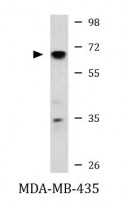ARG55375
anti-KCNQ1 antibody
anti-KCNQ1 antibody for Western blot and Human
Cell Biology and Cellular Response antibody; Metabolism antibody; Neuroscience antibody; Signaling Transduction antibody
Overview
| Product Description | Rabbit Polyclonal antibody recognizes KCNQ1 |
|---|---|
| Tested Reactivity | Hu |
| Tested Application | WB |
| Host | Rabbit |
| Clonality | Polyclonal |
| Isotype | IgG |
| Target Name | KCNQ1 |
| Antigen Species | Human |
| Immunogen | KLH-conjugated synthetic peptide corresponding to aa. 4-33 (N-terminus) of Human KCNQ1. |
| Conjugation | Un-conjugated |
| Alternate Names | Voltage-gated potassium channel subunit Kv7.1; KQT-like 1; JLNS1; LQT; KVLQT1; Kv1.9; KCNA9; IKs producing slow voltage-gated potassium channel subunit alpha KvLQT1; SQT2; RWS; LQT1; WRS; KCNA8; ATFB3; Potassium voltage-gated channel subfamily KQT member 1; Kv7.1; ATFB1 |
Application Instructions
| Application Suggestion |
|
||||
|---|---|---|---|---|---|
| Application Note | * The dilutions indicate recommended starting dilutions and the optimal dilutions or concentrations should be determined by the scientist. | ||||
| Positive Control | MDA-MB-435 |
Properties
| Form | Liquid |
|---|---|
| Purification | Purification with Protein A and immunogen peptide. |
| Buffer | PBS and 0.09% (W/V) Sodium azide |
| Preservative | 0.09% (W/V) Sodium azide |
| Storage Instruction | For continuous use, store undiluted antibody at 2-8°C for up to a week. For long-term storage, aliquot and store at -20°C or below. Storage in frost free freezers is not recommended. Avoid repeated freeze/thaw cycles. Suggest spin the vial prior to opening. The antibody solution should be gently mixed before use. |
| Note | For laboratory research only, not for drug, diagnostic or other use. |
Bioinformation
| Database Links |
Swiss-port # P51787 Human Potassium voltage-gated channel subfamily KQT member 1 |
|---|---|
| Gene Symbol | KCNQ1 |
| Gene Full Name | potassium channel, voltage gated KQT-like subfamily Q, member 1 |
| Background | This gene encodes a voltage-gated potassium channel required for repolarization phase of the cardiac action potential. This protein can form heteromultimers with two other potassium channel proteins, KCNE1 and KCNE3. Mutations in this gene are associated with hereditary long QT syndrome 1 (also known as Romano-Ward syndrome), Jervell and Lange-Nielsen syndrome, and familial atrial fibrillation. This gene exhibits tissue-specific imprinting, with preferential expression from the maternal allele in some tissues, and biallelic expression in others. This gene is located in a region of chromosome 11 amongst other imprinted genes that are associated with Beckwith-Wiedemann syndrome (BWS), and itself has been shown to be disrupted by chromosomal rearrangements in patients with BWS. Alternatively spliced transcript variants have been found for this gene. [provided by RefSeq, Aug 2011] |
| Function | Probably important in cardiac repolarization. Associates with KCNE1 (MinK) to form the I(Ks) cardiac potassium current. Elicits a rapidly activating, potassium-selective outward current. Muscarinic agonist oxotremorine-M strongly suppresses KCNQ1/KCNE1 current in CHO cells in which cloned KCNQ1/KCNE1 channels were coexpressed with M1 muscarinic receptors. May associate also with KCNE3 (MiRP2) to form the potassium channel that is important for cyclic AMP-stimulated intestinal secretion of chloride ions, which is reduced in cystic fibrosis and pathologically stimulated in cholera and other forms of secretory diarrhea. [UniProt] |
| Cellular Localization | Cell membrane; Multi-pass membrane protein Cytoplasmic vesicle membrane; Multi- pass membrane protein |
| Research Area | Cell Biology and Cellular Response antibody; Metabolism antibody; Neuroscience antibody; Signaling Transduction antibody |
| Calculated MW | 75 kDa |
| PTM | Phosphorylation at Ser-27 by PKA; increases delayed rectifier potassium channel activity of the KCNQ1-KCNE1 complex through a macromolecular complex that includes PKA, PP1, and the targeting protein AKAP9. Ubiquitinated by NEDD4L; promotes internalization (PubMed:22024150). The ubiquitinylated form is internalized through a clathrin-mediated endocytosis by interacting with AP2M1 and is recycled back to the cell membrane via RAB4A and RAB11A (PubMed:23529131). Deubiquitinated by USP2; counteracts the NEDD4L-specific down-regulation of I(Ks) and restores the membrane localization. |
Images (1) Click the Picture to Zoom In






